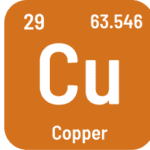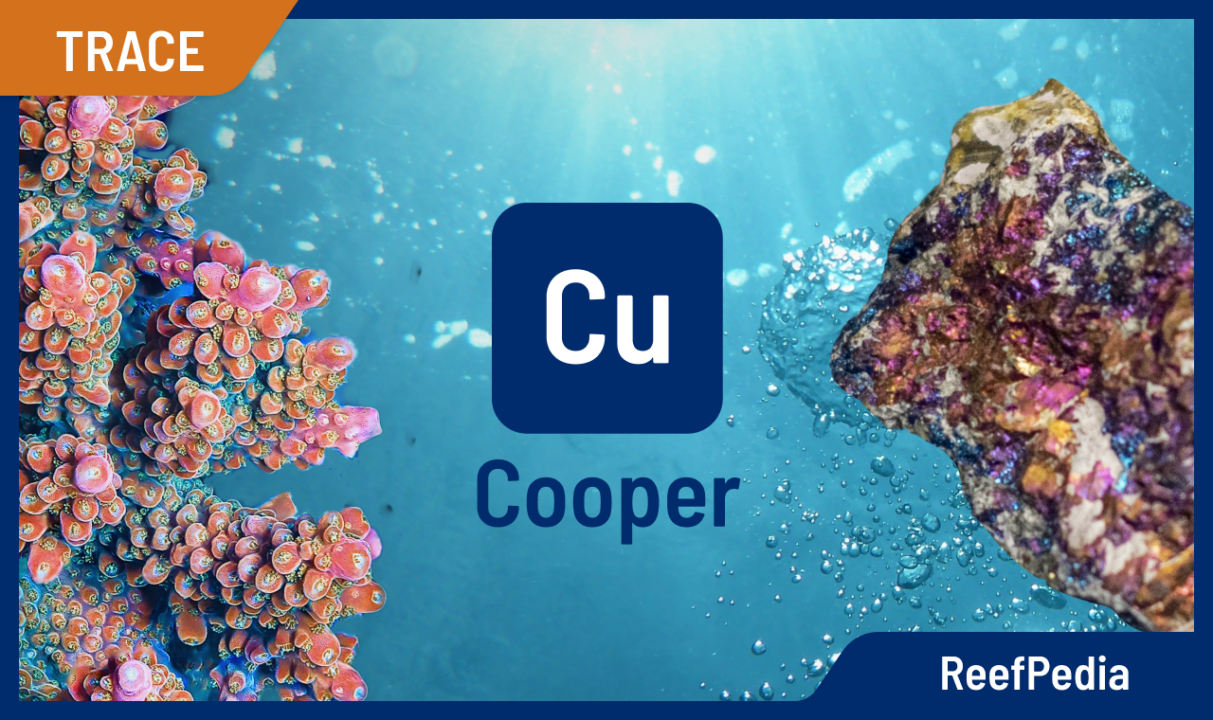Table of Contents

What is COPPER (Cu)?
Copper (Cu, Latin: cuprum) is an element belonging to the group of transition metals, located in the eleventh group of the periodic table. It is present in small amounts in the Earth’s crust, mainly in the form of native copper (Cu) and ores (minerals), the most important of which are: covellite, chalcocite, chalcopyrite, and bornite. Copper forms numerous chemical compounds, in which it mainly appears in the +I and +II oxidation states, and copper compounds in the +III oxidation state are also known.
The importance of copper in seawater
In the aquarium industry, copper is commonly considered harmful, if not toxic, and it is often recommended to eliminate it completely. However, this is a misconception, as copper is an important element in saltwater aquariums, as you will learn later in the article.
It’s worth noting that the harmfulness of a particular element in saltwater depends on the form (chemical compound) in which it is present in the aquarium.
Copper is an essential trace element that influences various physiological processes. It is a component of many important chemical compounds involved in enzymatic processes, making it indispensable. Its level should be maintained within the recommended range of 0.1 – 3 µg/l.
It should be noted that the amount of copper in saltwater, which is necessary for animals’ proper development, is so low that it is often not detectable by commonly used analytical methods. This doesn’t always mean that copper is not present in the water; rather, the detection limits of the devices determine its detectability (LOD – Limit of Detection).
Problems related to copper deficiency and excess in seawater
Low copper concentrations can have a negative impact on copper-containing enzyme-related processes.
High copper levels (around 20 µg/l and above) are harmful and can lead to many problems in animals, and even to the death of corals. This process occurs gradually; initially, significant bleaching of Acropora (later Seriatopora or Montipora) and soft corals can be observed.
The toxicity of copper to living organisms also depends on other elements that are directly associated with it. These include zinc (Zn), vanadium (V), nickel (Ni), and molybdenum (Mo). Additionally, copper typically occurs in the form of complex compounds and is bound to surfaces such as biofilms or decorations, making it less bioavailable and therefore less toxic.
In anaerobic zones, high copper levels combined with high concentrations of hydrogen sulfide increase the amount of poorly soluble copper compounds (such as copper sulfide – CuS2), which precipitate in seawater, forming deposits like copper sulfide sediment.
Cu +2H2S → CuS2 + 2H2 ↓ (1)
How to protect your aquarium?
Regularly monitoring copper levels and maintaining them at the proper level is important. We recommend keeping copper levels within the range of 0.1-3 µg/L, with the optimal value being around 1 µg/L. Maintaining copper at the appropriate level in saltwater aquariums ensures the health of the animals and enhances their vibrant colors.
The most accurate and reliable method for measuring copper is through ICP-OES analysis. Inductively Coupled Plasma Optical Emission Spectrometry (ICP-OES) is the most precise analytical method for determining the elemental composition of seawater.
Indicators of abnormal copper levels in a saltwater aquarium
Very good indicators of the proper level of copper in saltwater are Acropora, Seriatopora, Pocillopora, and Montipora corals.
Deficiency:
- Disruption of metabolic processes
Excess:
- Lightening of coral tissue
- Matting of tissue
- Tissue detachment
- Decrease in skeletal growth
- Death of mollusks (mussels, snails, shrimp) followed by coral
- Loss of zooxanthellae
Recommendations
To ensure the appropriate level of copper in the aquarium, you should regularly test it and maintain it at the correct level.
If the copper level is above 3 µg/l, it indicates an excess of the recommended content in the reef tank. The most common reasons for exceeding the recommended copper level are:
- salt,
- excessive doses of administered fluids,
- contaminated supplements,
- rusty impeller pumps,
- worn cables in contact with water,
- connections in RO systems,
- copper pipes delivering tap water.
Find and eliminate the cause of the problem and reduce the value of this parameter in the water. Perform up to 6 replacements. It is recommended that during each change, approximately 15% of the aquarium water volume should be replaced until the recommended value of this parameter is achieved. The replacement water must have the appropriate target salinity level. Use salts with the correct parameters and composition suitable for conducting an ICP test.
Under normal conditions, copper is delivered to the aquarium along with plankton, frozen foods, and is included in commercially available components for daily use. In most cases, the demand for this element by living organisms is sufficient. Experienced aquarists choose occasional supplementation of this element, but caution must be exercised.
*Transition metals – a group of chemical elements in the periodic table, including the side groups of the periodic table, i.e., groups 3-12.
Summary
Copper, although sometimes considered harmful, actually plays a crucial role in physiological and enzymatic processes, affecting the health as well as the colorful appearance of marine animals. Regulating the amount of this element in the tank requires experience and precision.
About author

Magdalena Metzler
Privately, I am a mother and a lover of nature and sport. My main interest is quantum chemistry, which hides a whole lot of unsolved mysteries and connections, which is extremely exciting from a scientific point of view.
In my scientific career, I have conducted international projects focused on innovative solutions for many branches of business, e.g. automotive, construction, and now, of course, marine aquaristics.
Working at Reef Factory gave me a passion for marine aquaristics, which I can develop every day, building a chemistry department and creating products that will help aquarists take care of tanks and ensure the highest safety of animals. One of the most exciting memories of working at Reef Factory is the commissioning of the ICP-OES spectrometer, which analyzes the elemental composition of seawater. The method of analysis in ICP is based on an analytical technique, which is a combination of my passion for quantum chemistry and marine aquaristics.
I hope you find my articles on ReefPedia interesting and helpful! Happy reading :))

